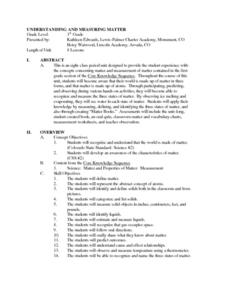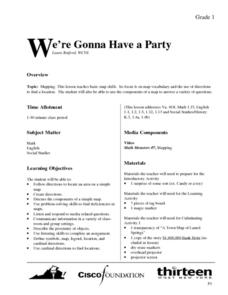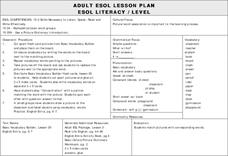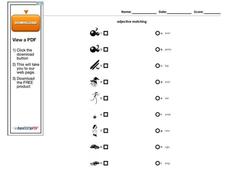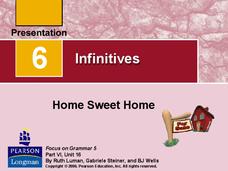Curated OER
Climate Mime-it
Young scholars pantomime new climate vocabulary words. In this climate lesson, students go over new vocabulary words and their meanings. Young scholars form groups and pantomime these word's definitions.
Curated OER
Understanding And Measuring Matter
First graders observe ice melting and water evaporating. They experiment with sugar and water and read the poem "Matter Really Matters." They define vocabulary words and sing a matter song.
Curated OER
People, Places, and Things
Students review art history in the Memphis Brooks Museum of Art. In this art history lesson, students discuss art vocabulary emphasizing landscape, portrait, and still life. They visit the museum and create their own pictures.
Curated OER
The Five Senses - Magic School Bus
Students identify five senses, draw parts of body that relate to each of the senses, hear different sounds in the environment, write those experiences in their journals, and list at least four objects/things that relate to each of the...
Curated OER
How to Haiku: Poetry Reflecting the Feelings in Art
Students discover the elements and subjects of haiku poetry. They observe and describe the objects in a landscape painting. They write a haiku based on the feelings evoked by the painting.
Curated OER
Living or Non-Living
Students examine living and non-living things. In this life science instructional activity, students are given a group of objects and discuss if they are living or non-living. Students identify and list characteristics of living things.
Curated OER
Magnets
Students conduct an experiment. In this magnets lesson, students review what they know about magnetism, work in groups to determine the magnetism of various objects and discuss their results.
Alabama Learning Exchange
Animal Classification
Present information about the classification of animals. After participating in the teacher-led discussion about scientific names, small groups devise their own way of classifying everyday objects present in the classroom, developing...
Curated OER
We're Gonna Have A Party
First graders explore map skills. They discuss the map vocabulary and use directions to find a location on a map. Students discuss and use the components of a map to answer a variety of questions. They use the map and directions to find...
Curated OER
All Aboard! Railroad Transportation
Students create a picture of a train. In this train lesson, students read Freight Trainand discuss the trains that they see. Students discuss what it would feel like to be a train and play a game where they pretend to be a train. They...
Curated OER
3-D Attributes
Students explore geometric solids. In this geometry instructional activity, students listen to the book The Greedy Triangle by Marilyn Burns, then work in groups to sort geometric solids into various categories. Students define geometric...
Curated OER
ADULT ESOL LESSON PLAN--Skills Necessary to Listen, Speak, Read and Write Effectively
Students practice alphabetizing basic word groups (classroom, playground, etc.) with flash cards and a Picture Dictionary. They realize the importance of communication correctly with others through picture/word association.
Curated OER
Adjective Matching
In this ESL adjective vocabulary worksheet, students analyze 7 pictures that depict different objects that can be easily described. Students match these pictures with the adjectives that tell about them.
Curated OER
Halloween Match
In this Halloween word worksheet, students examine 5 pictures of Halloween objects. Students read the riddles in another column, write the answer and then match it to the picture it describes.
J. Paul Getty Trust
Still-Life Painting: Arranging Nature—Lesson 1
Art learners examine still-life arrangement images and respond to a series of prompts. In a whole-class discussion, pupils list elements and qualities that still-life paintings can have. After instructors create an arrangement and model...
Core Knowledge Foundation
A “Whole” Lot of Fraction Fun!
Young mathematicians are introduced to fractions in a unit that helps them to understand parts of a whole.
Cornell University
Glued into Science—Classifying Polymers
Explore the unique characteristics of polymers. A complete lesson begins with a presentation introducing polymers. Following the presentation, young scientists develop a laboratory plan for creating substances using polymers. They test...
It's About Time
Force Fields
Young scholars investigate both bar and horseshoe magnets. They explore force fields with a compass and iron fillings before making an electromagnet. This is the first in a series of nine lessons.
Macmillan Education
Teamwork
Learners develop self-awareness and discuss the importance of cooperation and communication through worksheets and hands-on, collaborative activities.
Pearson
Infinitives
If you want to buy a house, what's the first thing you need to do? Learn about buying a home, and about infinitive phrases, with a helpful and straightforward slideshow presentation.
Azar Grammar
Song Lessons: Father and Daughter
Paul Simon's "Father and Daughter" offers language learners and native English speakers an opportunity to study adverb, adjective, and noun clauses.
Curated OER
Shoes and the Backyard Landscape
Your shoes get a lot of mileage in familiar places. Represent the places you have traveled the most with an art project based on a print of Indian People Wear Shoes and Socks by Juane Quick-to-See Smith. Kids trace their shoes and draw...
ESL Kid Stuff
Numbers 1-20
Language learners engage in a series of games and activities designed to help them recognize and name the numbers from ten to twenty.
It's About Time
Elements and Compounds
Young scientists use electrolysis to separate water into its elements before experimenting with fire to learn about their properties. A helpful resource provides a reading passage and analysis questions.



